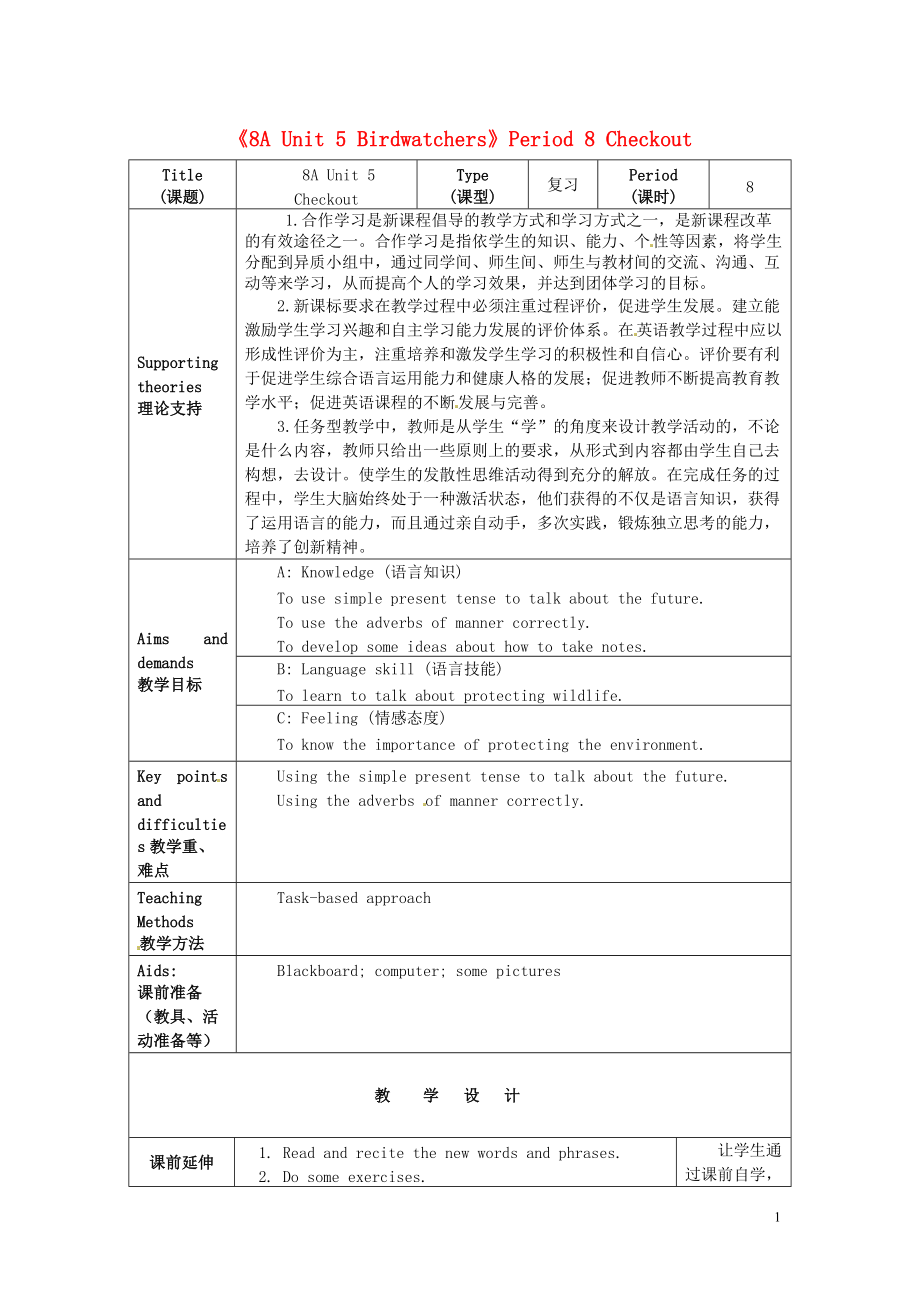《初級中學(xué)八年級英語上冊《8A Unit 5 Birdwatchers》Period 8 Checkout教案 牛津版》由會(huì)員分享�����,可在線閱讀�����,更多相關(guān)《初級中學(xué)八年級英語上冊《8A Unit 5 Birdwatchers》Period 8 Checkout教案 牛津版(3頁珍藏版)》請?jiān)谘b配圖網(wǎng)上搜索�����。
1、
《8A Unit 5 Birdwatchers》Period 8 Checkout
Title
(課題)
8A Unit 5 Checkout
Type
(課型)
復(fù)習(xí)
Period
(課時(shí))
8
Supporting theories
理論支持
1.合作學(xué)習(xí)是新課程倡導(dǎo)的教學(xué)方式和學(xué)習(xí)方式之一�����,是新課程改革的有效途徑之一�����。合作學(xué)習(xí)是指依學(xué)生的知識�����、能力�����、個(gè)性等因素�����,將學(xué)生分配到異質(zhì)小組中�����,通過同學(xué)間、師生間�����、師生與教材間的交流�����、溝通�����、互動(dòng)等來學(xué)習(xí)�����,從而提高個(gè)人的學(xué)習(xí)效果,并達(dá)到團(tuán)體學(xué)習(xí)的目標(biāo)�����。
2.新課標(biāo)要求在教學(xué)過程中必須注重過程評價(jià)�����,促進(jìn)學(xué)生發(fā)展�����。建立能
2�����、激勵(lì)學(xué)生學(xué)習(xí)興趣和自主學(xué)習(xí)能力發(fā)展的評價(jià)體系�����。在英語教學(xué)過程中應(yīng)以形成性評價(jià)為主�����,注重培養(yǎng)和激發(fā)學(xué)生學(xué)習(xí)的積極性和自信心�����。評價(jià)要有利于促進(jìn)學(xué)生綜合語言運(yùn)用能力和健康人格的發(fā)展;促進(jìn)教師不斷提高教育教學(xué)水平�����;促進(jìn)英語課程的不斷發(fā)展與完善�����。
3.任務(wù)型教學(xué)中�����,教師是從學(xué)生“學(xué)”的角度來設(shè)計(jì)教學(xué)活動(dòng)的�����,不論是什么內(nèi)容�����,教師只給出一些原則上的要求�����,從形式到內(nèi)容都由學(xué)生自己去構(gòu)想�����,去設(shè)計(jì)�����。使學(xué)生的發(fā)散性思維活動(dòng)得到充分的解放。在完成任務(wù)的過程中�����,學(xué)生大腦始終處于一種激活狀態(tài)�����,他們獲得的不僅是語言知識�����,獲得了運(yùn)用語言的能力,而且通過親自動(dòng)手�����,多次實(shí)踐�����,鍛煉獨(dú)立思考的能力�����,培養(yǎng)了創(chuàng)新精神�����。
Aims
3�����、and demands
教學(xué)目標(biāo)
A: Knowledge (語言知識)
To use simple present tense to talk about the future.
To use the adverbs of manner correctly.
To develop some ideas about how to take notes.
B: Language skill (語言技能)
To learn to talk about protecting wildlife.
C: Feeling (情感態(tài)度)
To know the importance of
4�����、 protecting the environment.
Key points and difficulties教學(xué)重�����、難點(diǎn)
Using the simple present tense to talk about the future.
Using the adverbs of manner correctly.
Teaching Methods
教學(xué)方法
Task-based approach
Aids:
課前準(zhǔn)備(教具�����、活動(dòng)準(zhǔn)備等)
Blackboard; computer; some pictures
教 學(xué) 設(shè) 計(jì)
課前延伸
1. Rea
5�����、d and recite the new words and phrases.
2. Do some exercises.
讓學(xué)生通過課前自學(xué)�����,小組內(nèi)的團(tuán)結(jié)合作解決預(yù)習(xí)中的一些問題�����,為上課做準(zhǔn)備
Teaching Plan
(授課計(jì)劃)
Studying Plan
(學(xué)習(xí)計(jì)劃)
Aims
(設(shè)計(jì)意圖)
課
內(nèi)
探
究
學(xué)
StepⅠWarm up
1. Guessing words and phrases.
2. Exercises.
1. A guessing g
6�����、ame of words.
(The students say some words according to the pictures on the screen.)
2. Exercises.
(The students do some exercises.)
復(fù)習(xí)熱身�����, 通過游戲的形式檢查預(yù)習(xí)情況�����,激發(fā)學(xué)生興趣�����。
導(dǎo)
Step II Practice
Revision of the simple present tense and the adverbs.
1. Work in pairs.
2. Draw the rules.
3. Do some exercis
7�����、es.
1. 訓(xùn)練學(xué)生通過合作解決問題的能力�����。適時(shí)進(jìn)行過程性評價(jià)�����。
2. 通過當(dāng)堂練習(xí)與反饋�����,對學(xué)生進(jìn)行適當(dāng)?shù)慕忸}方法及技巧的指導(dǎo)�����。
練
Step Ⅲ Production
Discussion
1. Birds in Zhalong.
2. Talk about a special place.
Questions:
1. Do you know the parts of birds?
2. What is it?
3. What can we do for Zhalong?
T
8�����、alk about birds in Zhalong
1. Show some pictures of the parts of birds.
2. According to the explanation to tell what it is.
3. Fill in the blanks.
4. Do something to protect the birds.
欣賞flash并用英語談?wù)揻lash內(nèi)容�����,加深對本課的理解�����,培養(yǎng)學(xué)生的口語表達(dá)能力�����。
課后提升
Step Ⅳ Assignment
1. Read some articles about wildlife.
9�����、
2. Write something about all kinds of birds.
3. Find more information about wild life
1. Read some articles about wildlife.
2. Write something about all kinds of birds.
3. Find more information about wildlife.
考查學(xué)生的 基礎(chǔ)知識與閱讀能力以及分析文章框架結(jié)構(gòu)的能力。
要求學(xué)生根據(jù)以上語篇的結(jié)構(gòu)及特點(diǎn)�����,讓學(xué)生描寫與本單元話題或體裁有關(guān)的文章�����,達(dá)成語言輸出的目標(biāo)�����。
3
 初級中學(xué)八年級英語上冊《8A Unit 5 Birdwatchers》Period 8 Checkout教案 牛津版
初級中學(xué)八年級英語上冊《8A Unit 5 Birdwatchers》Period 8 Checkout教案 牛津版

